Sunday, January 10, 2010
Friday, January 8, 2010
Wednesday, December 16, 2009
Evaluation
1. In what ways does your product use/develop/challenge forms and conventions of the real media products?
Framing
The ways of which our documentary relates to other expository documentaries as it has a 'Voice of god' narrator and also uses professional interviews with the use of cutaways and archive material.
This shows that it follows many of the same codes and conventions. For instance it follows the same conventions for the framing of interviews.
This is a screen grab below is from a documentary called Caravans: A British Love Affair.
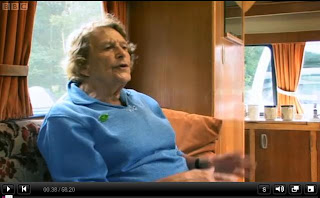
http://www.bbc.co.uk/programmes/b00hw3s0/Caravans_A_British_Love_Affair/
The screen grab below is taken from our Halloween: Things that go bump in the night documentary.
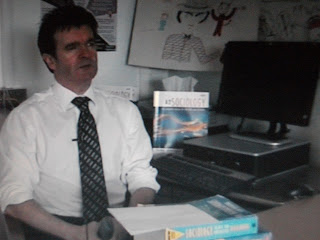
As you can see in both screen grabs the interviewee's have been placed in mid-shot with the mise-en-scene representing their authority.
As you can see for the mise-en-scene of the interview in the caravan documentary, the woman is sat inside a caravan while she is being interviewed. This has been done so that it connotes the documentary of being about caravans.
In the Halloween documentary, for the mise-en-scene we have placed the sociologist in a classroom surrounded with sociology books to connote his authority of being a sociologist.
As you can see from both screen grabs they both share the codes and conventions of documentary interviews due to the layout of the shot and the use of the mise-en-scene to connote their authority figure to the documentary.
Use Of Graphics
The use of graphics are used to tell us (the audience) who the person in the shot is and what relevance they have in the documentary.
We have used the same conventions in the graphics in our documentary so it follows the codes and conventions. The ways of which they relate to each other; the graphics are both places on the left hand side, their name at the top then their status underneath and usually use a block colour so that it stands out.
The screen grab below is taken from the documentary: Most annoying people - 2009 cutdowns.
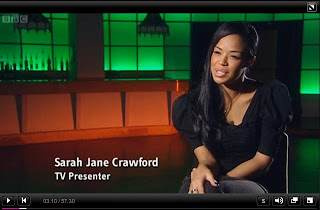
http://www.bbc.co.uk/iplayer/episode/b00ps1t1/Most_Annoying_People_2009_Cutdowns_Part_1/
The screen grab below is taken from our Halloween: Things that go bump in the night documentary.
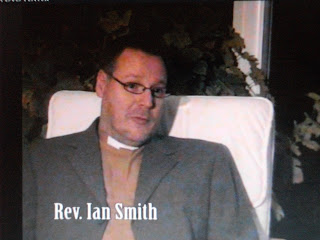
As you can tell we have used the same codes and conventions as other documentaries.
Narrative Structure
For our documentary we followed a single strand narrative which professional documentaries all follow so that the audience don't get confused and turn over the channel.
Use Of Cutaways
We managed to find a animation website where we were able to carve our own pumpkin on this website which we have used for the opening credits.
We carved out the word halloween into the pumpkin and we did it so that a new letter would appear for example: we started with the 'H' then 'HA' then 'HAL' etc.
The video below is basically a video showing the website that we used to do the pumpkin carving.
http://www.theoworlds.com/halloween/
The video below is one of our interviews which includes cutaways. For the cutaways, we made it relevant to what the interviewee was actually saying as the interviewee is talking about dunk apple which is a traditional Halloween game.
The video below is taken from a documentary called 'Amazing Gracie'. It is a man talking about the life of this woman and cutaways of this woman are used.
http://www.bbc.co.uk/programmes/b0074qlt/Amazing_Gracie_the_Gracie_Fields_story/
Voice Over / Narration
For the voice over, we used a male voice as male's tend to be represented as more spooky voice's and they tend to have deeper voices then woman.
However in the documentary we do not see the narrator like in some documentaries e.g. 'The Crocodile Hunter.'
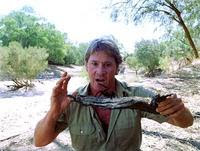
This is 'Voice of god' due to the fact we do not see the narrator all we do is simply hear their voice.
Use Of Music And Achive Material
For the music and achive material we were hoping to use well known films and music so that the audience would be able to relate to the documentary. We picked Halloween themed filmed such as Halloween, Hocus Pocus etc.
For this we wrote emails to the companies that make these films to see whether we could use them in our media documentary.
Below are screen grabs of the emails that we sent asking for permission.
This first email is to Warner Brothers asking whether we could use a scene from Wickerman (2006) in our Halloween documentary as a cut away.
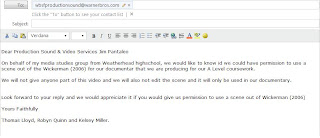
This email is an email to Compass International Pictures regarding whether we could use a scene from Halloween(1978) in the documentary.
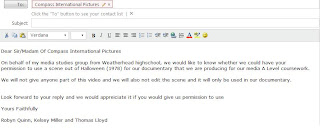
This email is to Walt Disney Pictures to ask for permission to use a scene from Hocus Pocus.
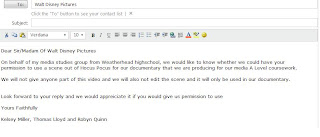
This last email is to Island Records asking whether we are able to use a song as our opening credit music.

Below is the audio clip of the music that we would like to use which we have altered for our documentary so that it could be in the opening sequence.
Basically we have used these because they have themes of Halloween for example Halloween parties where people are dressed up in Halloween costumes, people trick or treating. Music for example from Halloween which instantly relates people to think of Halloween due to the film obviously being called Halloween.
We have used these to target a wider audience because they relate well with each other due to the themes and the connotations of Halloween. It also shows how Americanised things are due to the traditions in the films.
2.How effective is the combination of your main product and ancillary tasks?
Title
Coherence is created across the package of the Video, Trailer and Print Ad in many ways as they all link together as they are all representing the same thing. They all share the same title of; Halloween things that go bump in the night.
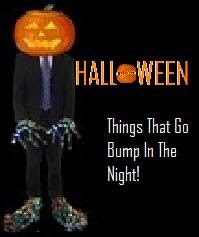
Channel
The channel we have planned to schedule our documentary on is Channel 4 because the audience we have chosen to target mainly watch Channel 4. The result of this has been taken from the questionnaire analysis where most people said they tend to watch channel 4 from 9-10 pm.
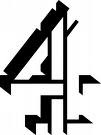
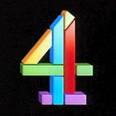
Scheduling
For the scheduling of our documentary we have planned for it to be on at 9.30pm on Halloween night. The main reason of it being on Halloween night is simply because it is about the origins of Halloween and people tend to be at home as it would usually be the time people tend to start settling down.
We chose to schedule the documentary on Channel 4 due to the fact it has several niche audiences and as one of the niche audiences are similar to our target audience we felt that it would be the best channel to have our documentary scheduled on.
The reason we picked Channel 4 over the BBC is due to the fact that Channel 4 sells its advertising to increase the viewings and Channel 4 doesn't get paid for by TV licenses so all their money is made by the advertising. However BBC charge a license fee.
Below is a quote which was made by Channel 4:
"The public service remit for Channel 4 is the provision of a broad range of high quality and diverse programming which, in particular:
•Demonstrates innovation, experiment and creativity in the form and content of programs.
•Appeals to the tastes and interests of a culturally diverse society.
•Makes a significant contribution to meeting the need for the licensed public service channels to include programs of an educational nature and other programs of educative value.
•Exhibits a distinctive character."
Voice Over
For the voice over we used a man as they tend to have deeper voices which sometimes can sound quite spooky. As well as the documentary we asked him to do the Radio Advert as well so that the voice over of them both would both be the same so that they are relating to each other due to the voice being the same so the audience would be able to instantly recognise what its about if they have heard this voice over about the documentary.
At the end of the Radio Advert there is another voice over and for this we used a woman's voice simply so that the audience could hear when the documentary is going to be broadcast. The different change in voice keeps them listening.
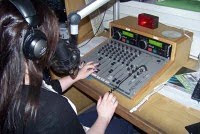
The image below is an image of the person we have used for the voice over.
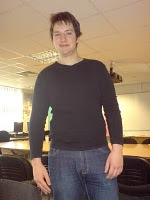
Slogan Used In Trailor And Print
In the Print Advert and the Radio Advert they both use the slogan of: 'Tune in if you dare'. This has been done to make it seem 'spooky' due to the fact that its halloween. Basically playing with the audiences minds to thinking that its really scary which would make them want to find out whats scary about the documentary.
Extracts From Programme In Trailer
From the documentary, we have used some of the voxpops saying their views of Halloween in the radio advert and we have also used the same music which has been used in the opening of the documentary for the soundbed in the radio advert.
Key Image In Print Advert
The key image in the print advert is of a body with a pumpkin head and sweets for hands and feet.
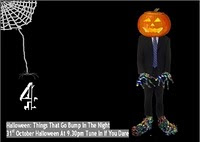
The pumpkin is used as it represents Halloween as a whole because immigrants came to America in the 1800s during the Irish Potato Famine, bringing with them the traditions of Halloween and the use of Jack O Lanterns. The pumpkin jack o- lantern has been an essential part of Halloween celebrations since the Victorian days and today is a universal symbol of Halloween.
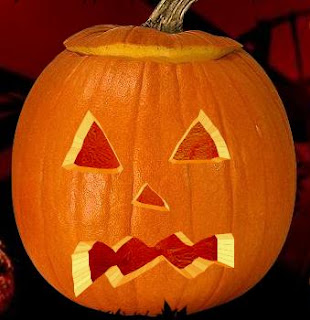
The reason we have used sweets for the hands and feet as it has connotations of trick or treat which Trick-or-treating is a custom for children on Halloween.
Children proceed in costume from house to house, asking for treats such as candy, or sometimes money, with the question, "Trick or treat?" The "trick" is an idle threat to perform mischief on the homeowners or their property if no treat is given.
Below is the Print ad which i have annotated explaining each of the things on there.
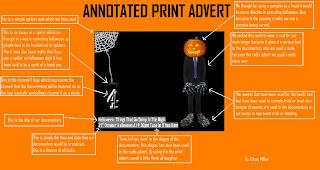
Style Of Documentary
We decided to make an 'Expository documentary' as it is mainly characterised by ‘voice of god’ narration. The voice over will anchor the meaning to the images. Usually expository documentaries are based around a problem which needs solving therefore the basis of this documentary will be the discovery of the development of Halloween. Understanding that documentaries are rarely ever pure of a specific style, there will also be hints of observational. This will be shown through clips of trick or treater’s and also people shopping for Halloween treats, costumes and decorations.
Way It Addresses The Audience
The ways the documentary addresses the audience is the ways it uses well known film extracts and goes on about where halloween originates. Also due to the scheduling of the documentary it will no doubt address the audience. For example the channel of the documentary. The scheduling was based around our questionnaires that we had filled in and from the results we were able to find out what channel and time the target audience watch television and whether or not they would be interested in a halloween documentary.
Appeal To The Audience
We have done a radio advert and print advert so we are hoping that they would appeal to the audience.
When And Where Would The Radio Advert Be Played And The Print Advert Be Placed
For both the radio advert and the print advert we made a mood board simply with the logos of the radio stations and newspapers that the adverts would feature on/in.
The radio advert would be mainly featured on commercial radio stations due to the fact that it is programmed to be on channel 4 not the BBC.
The radio stations that have been picked tend to all have the same target audience.
We have planned for our radio advert to be played between 7-10 pm.
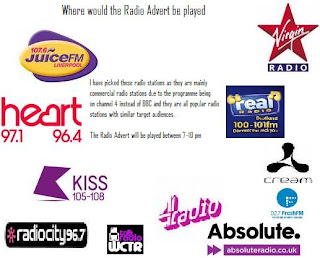
The print advert would mainly feature in middle market tabloid newspapers due to the fact that they all tend to target the same audience.
Below are the newspapers that the print advert would possibly be a feature in.
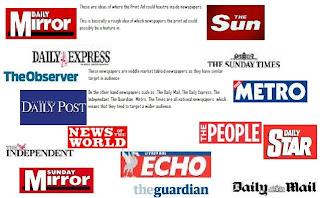
Examples of other Print and Radio adverts
We have also found some example of other Print and Radio adverts.
Below are two example of Print adverts. The first image is a Print advert from Channel 5 which is about the news. The second advert is taken from Channel 4 which is about Derren Brown.
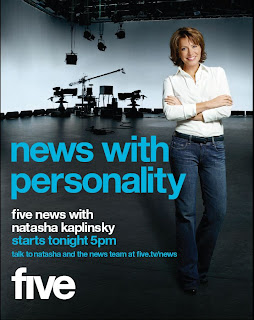
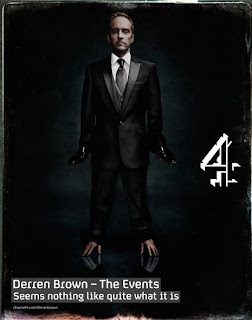
Below is a video containing various audio clips of radio adverts.
3. What have you learned from your audience feedback?
For the audience feedback we managed to get a group together and made them watch the documentary, look at the print advert and also listen to the radio advert. We also asked them a few questions basically to help us improve our documentary and adverts in order to make it look more professional and to get the best grade possible.
During the process we filmed them while they were watching, looking and listening to the full package and afterwards we asked them the question.
The questioned that we used were:
Radio advert:
1) Do you think the radio ad is interesting?
2) Would it make you want to watch the programme?
3) How do you think halloween has been represented in this?
4) How do you think we could improve this?
The video below is audio clips of the audience feeding back with their answers/ opinions to the questions.
Documentary:
1) Do you think the opening sequence is effective and makes you understand what it is about?
2) What do you think about the layout of the interviews?
3) Do you like the cutaways that have been used?
4) Would you continue watching this documentary?
5) What suggestions do you have to improve?
6) Do you think the voice over is effective in the terms of capturing the audiences attention?
This image below is an image of Tom with his opinion about the documentary: "It’s really interesting and I like the use of cut aways and SFX."
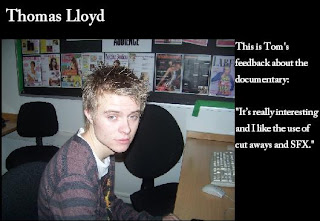
The image below is anb image of Sasha with her opinion about the documentary: "It looks really professional and I would definitely be interested in watching the rest of it."

This next image is an image of Natalie with her opinion about the documentary: "The use of cut aways are really effective in the ways it relates to the interview."

The next image is an image of Whitney with her opinion on the documentary: "I like the voice over because he sounds dark and mysterious and this fits in well with the theme of Halloween."
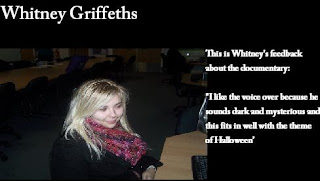
This image below is an image of robyn with her opinion on the Print advert: "The print ad is eye catching because it makes me wonder why there is a suit with a pumpkin head, then I see its for a documentary and I want to find out more."
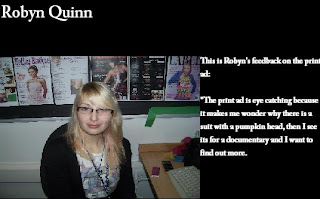
This image below is an image of Becky and her opinion on the radio advert: "The radio links with the other tasks well and is interesting."
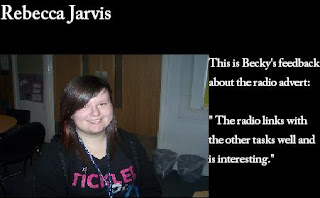
The image below is and image of Jonny with his opinionon the documentary: "I like the music used as it is a known song but its different and it makes me want to watch more of the documentary."

This image below is of Radu with his opinion on the documentary: "It’s really spooky and I like that element in documentaries."

This image below is of Lisa with her opinion on the documentary: "The sound of the voice over is a bit quiet but I like the five minutes on a whole."
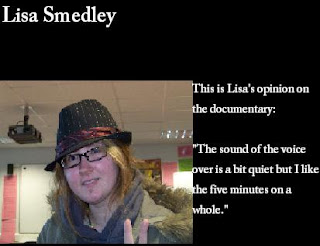
This image below is of Jess and her opinion on the documentary:"Some of the connections between the shot could be smoother, it jumps around a bit but the content is good."
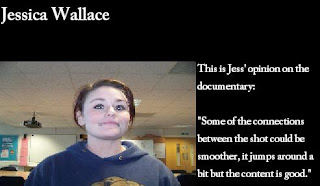
Conclusion
From this we have learnt how hard it is working in a group as people tend to have different opinions and have different ways of doing things. We have learned all about the codes and conventions of documentaries and also the styles of them for example: an expositry documentary contains a 'voice of god'.
From the audience feedback it shows that we have made a documentary that people are willing to watch and also from the audience feedback we are able to put things right for example: sound levels of the voice over so that he is more heard.
It also helps us in knowing what we did wrong and right in our documentary. We have had numerous problems with filming as we sometimes had to go film things again as the framing wasn't right. Overall we made a interesting documentary and got possitive feedback from the audience.
4.How did you use technology?
Without the use of technology we wouldn't of been able to do anything which is a fact.
Our blog has basically be a log of what we have done for example: Filming, editing planning scripts etc.
Video Camera
The main piece of technology was the video camera. The video camera is what we used to record all of our footage, interviews and voxpops. By using a video camera we are able to use many different camera transitions such as pan's and zoom's. We basically spent quite alot of our time recording footage and also redoing the same footage again if it was shakey. By using a tripod it kept the camera steady and also enabled us to do steady pans. The tripod also made the shot look more professional as if we filmed it 'hand held' the camera would just of been jittering everywhere. A hand held camera would look unprofessional with our style of documentary, if it were fly on the wall or (other type) then a hand held camera would add to the ambience.
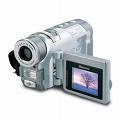

still image camera
Another source of technology that was used was a still image camera. This was used to take photographs of use using the different technology to put into our blog. Also we used it to take still images of merchandise which was going to be used for the cutaways. By using the still image camera we were able to keep track of our progress to show how we used technology.

Microphone
Microphones were used so that we could record sound as well as film. The microphone was plugged into the video camera so that they would pick up the sound.
Howevere there was a range of different microphones that were used for example:
Hand Held Microphone
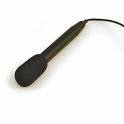
This microphone was used mainly to record the voxpops as these type of microphones tend to pick up the background noise aswell which made the voxpop seem more impersonal and gave it an unplanned feel.
Standing Microphone
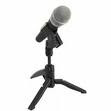
The standing microphone we used for the interview with the vicar. This was used because it made the interview sound like echo effect which matched our documentary as it made it more spooky. Also because he was talking about the churches point of view on halloween churches tend to be echoey. With this it enhanced what the vicar was saying.
Clip On Microphone
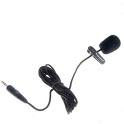
The clip on microphone was used in the interview with the sociologist. He had to do clip the microphone to himself and this microphone doesn't tend to pick up on background noise which worked well because at the time of recording this interview it was lunch time so the background would have been picked up in the interview. But luckily we picked the right microphone for this interview.
Problems we encounted with microphones
We encounted many problems with microphone and this meant that we had to re-record things due to the lack of sound. A main issue would be the microphone wouldn't work altogether so it wouldn't pick up any sound. Another issue was with one microphone the only sound we picked up was static. Therefore we tested out with many different microphones and thats how we managed to sort out with microphone was relevant to the interviews and cutaways due to the sound they picked up, made it echoey etc.
Dictaphone
The dictaphone meant we were able to do voice recordings.

Radio Suite
With having a school radio suite and with knowing how to use it, we used this to record our radio advert. Ine the radio suite their is Adobe audition which we used to record the actually advert.

Computer
The computer has been one of the main sources of technology during the process. As we do our blogs on the computer, we edited on the computer and made videos on the computer.

Adobe Premier Pro
Adobe Premier Pro was the software that we used to edit our documentary. First we had to plug the video camera into the computer then capture all the footage so that it was ready to be edited. With using this software we were able to use different transitions and effects such as fades, add in slide transitions. We were also able to speed up clips which we speeded up the pumpkin carving bit so that it didn't look to boring being slow. With it being fast pace makes the documentary seem interesting in the ways that we were able to make the clips speeded up.
I was probably the only one at the beginning of the editing process who knew how to use this software due to being a Film Studies student as well. However helping the other memebers of the group learn how to use it and when they got the hang of it they were able to do it them selves.

Adobe Audition
Adobe audition is the software which was used to edit sound clips for example the radio advert. This software enables you to have different layers of sound and this enabled them to be played at the same time. For example the sound bed with the voice over.
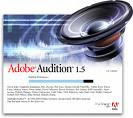
Adobe Photoshop
Adobe Photoshop was used to make the print advert. This is used as on this it enables you to manipulate and edit images to the way you want them.

Below is a mood board which I made showing all the different technology which was used.
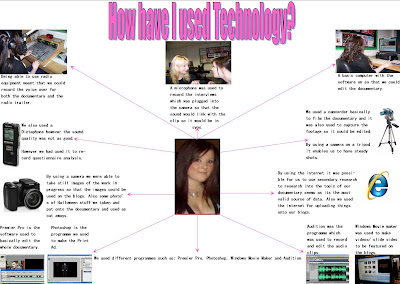 `
`
Framing
The ways of which our documentary relates to other expository documentaries as it has a 'Voice of god' narrator and also uses professional interviews with the use of cutaways and archive material.
This shows that it follows many of the same codes and conventions. For instance it follows the same conventions for the framing of interviews.
This is a screen grab below is from a documentary called Caravans: A British Love Affair.

http://www.bbc.co.uk/programmes/b00hw3s0/Caravans_A_British_Love_Affair/
The screen grab below is taken from our Halloween: Things that go bump in the night documentary.

As you can see in both screen grabs the interviewee's have been placed in mid-shot with the mise-en-scene representing their authority.
As you can see for the mise-en-scene of the interview in the caravan documentary, the woman is sat inside a caravan while she is being interviewed. This has been done so that it connotes the documentary of being about caravans.
In the Halloween documentary, for the mise-en-scene we have placed the sociologist in a classroom surrounded with sociology books to connote his authority of being a sociologist.
As you can see from both screen grabs they both share the codes and conventions of documentary interviews due to the layout of the shot and the use of the mise-en-scene to connote their authority figure to the documentary.
Use Of Graphics
The use of graphics are used to tell us (the audience) who the person in the shot is and what relevance they have in the documentary.
We have used the same conventions in the graphics in our documentary so it follows the codes and conventions. The ways of which they relate to each other; the graphics are both places on the left hand side, their name at the top then their status underneath and usually use a block colour so that it stands out.
The screen grab below is taken from the documentary: Most annoying people - 2009 cutdowns.

http://www.bbc.co.uk/iplayer/episode/b00ps1t1/Most_Annoying_People_2009_Cutdowns_Part_1/
The screen grab below is taken from our Halloween: Things that go bump in the night documentary.

As you can tell we have used the same codes and conventions as other documentaries.
Narrative Structure
For our documentary we followed a single strand narrative which professional documentaries all follow so that the audience don't get confused and turn over the channel.
Use Of Cutaways
We managed to find a animation website where we were able to carve our own pumpkin on this website which we have used for the opening credits.
We carved out the word halloween into the pumpkin and we did it so that a new letter would appear for example: we started with the 'H' then 'HA' then 'HAL' etc.
The video below is basically a video showing the website that we used to do the pumpkin carving.
http://www.theoworlds.com/halloween/
The video below is one of our interviews which includes cutaways. For the cutaways, we made it relevant to what the interviewee was actually saying as the interviewee is talking about dunk apple which is a traditional Halloween game.
The video below is taken from a documentary called 'Amazing Gracie'. It is a man talking about the life of this woman and cutaways of this woman are used.
http://www.bbc.co.uk/programmes/b0074qlt/Amazing_Gracie_the_Gracie_Fields_story/
Voice Over / Narration
For the voice over, we used a male voice as male's tend to be represented as more spooky voice's and they tend to have deeper voices then woman.
However in the documentary we do not see the narrator like in some documentaries e.g. 'The Crocodile Hunter.'

This is 'Voice of god' due to the fact we do not see the narrator all we do is simply hear their voice.
Use Of Music And Achive Material
For the music and achive material we were hoping to use well known films and music so that the audience would be able to relate to the documentary. We picked Halloween themed filmed such as Halloween, Hocus Pocus etc.
For this we wrote emails to the companies that make these films to see whether we could use them in our media documentary.
Below are screen grabs of the emails that we sent asking for permission.
This first email is to Warner Brothers asking whether we could use a scene from Wickerman (2006) in our Halloween documentary as a cut away.

This email is an email to Compass International Pictures regarding whether we could use a scene from Halloween(1978) in the documentary.

This email is to Walt Disney Pictures to ask for permission to use a scene from Hocus Pocus.

This last email is to Island Records asking whether we are able to use a song as our opening credit music.

Below is the audio clip of the music that we would like to use which we have altered for our documentary so that it could be in the opening sequence.
Basically we have used these because they have themes of Halloween for example Halloween parties where people are dressed up in Halloween costumes, people trick or treating. Music for example from Halloween which instantly relates people to think of Halloween due to the film obviously being called Halloween.
We have used these to target a wider audience because they relate well with each other due to the themes and the connotations of Halloween. It also shows how Americanised things are due to the traditions in the films.
2.How effective is the combination of your main product and ancillary tasks?
Title
Coherence is created across the package of the Video, Trailer and Print Ad in many ways as they all link together as they are all representing the same thing. They all share the same title of; Halloween things that go bump in the night.

Channel
The channel we have planned to schedule our documentary on is Channel 4 because the audience we have chosen to target mainly watch Channel 4. The result of this has been taken from the questionnaire analysis where most people said they tend to watch channel 4 from 9-10 pm.


Scheduling
For the scheduling of our documentary we have planned for it to be on at 9.30pm on Halloween night. The main reason of it being on Halloween night is simply because it is about the origins of Halloween and people tend to be at home as it would usually be the time people tend to start settling down.
We chose to schedule the documentary on Channel 4 due to the fact it has several niche audiences and as one of the niche audiences are similar to our target audience we felt that it would be the best channel to have our documentary scheduled on.
The reason we picked Channel 4 over the BBC is due to the fact that Channel 4 sells its advertising to increase the viewings and Channel 4 doesn't get paid for by TV licenses so all their money is made by the advertising. However BBC charge a license fee.
Below is a quote which was made by Channel 4:
"The public service remit for Channel 4 is the provision of a broad range of high quality and diverse programming which, in particular:
•Demonstrates innovation, experiment and creativity in the form and content of programs.
•Appeals to the tastes and interests of a culturally diverse society.
•Makes a significant contribution to meeting the need for the licensed public service channels to include programs of an educational nature and other programs of educative value.
•Exhibits a distinctive character."
Voice Over
For the voice over we used a man as they tend to have deeper voices which sometimes can sound quite spooky. As well as the documentary we asked him to do the Radio Advert as well so that the voice over of them both would both be the same so that they are relating to each other due to the voice being the same so the audience would be able to instantly recognise what its about if they have heard this voice over about the documentary.
At the end of the Radio Advert there is another voice over and for this we used a woman's voice simply so that the audience could hear when the documentary is going to be broadcast. The different change in voice keeps them listening.

The image below is an image of the person we have used for the voice over.

Slogan Used In Trailor And Print
In the Print Advert and the Radio Advert they both use the slogan of: 'Tune in if you dare'. This has been done to make it seem 'spooky' due to the fact that its halloween. Basically playing with the audiences minds to thinking that its really scary which would make them want to find out whats scary about the documentary.
Extracts From Programme In Trailer
From the documentary, we have used some of the voxpops saying their views of Halloween in the radio advert and we have also used the same music which has been used in the opening of the documentary for the soundbed in the radio advert.
Key Image In Print Advert
The key image in the print advert is of a body with a pumpkin head and sweets for hands and feet.

The pumpkin is used as it represents Halloween as a whole because immigrants came to America in the 1800s during the Irish Potato Famine, bringing with them the traditions of Halloween and the use of Jack O Lanterns. The pumpkin jack o- lantern has been an essential part of Halloween celebrations since the Victorian days and today is a universal symbol of Halloween.

The reason we have used sweets for the hands and feet as it has connotations of trick or treat which Trick-or-treating is a custom for children on Halloween.
Children proceed in costume from house to house, asking for treats such as candy, or sometimes money, with the question, "Trick or treat?" The "trick" is an idle threat to perform mischief on the homeowners or their property if no treat is given.
Below is the Print ad which i have annotated explaining each of the things on there.

Style Of Documentary
We decided to make an 'Expository documentary' as it is mainly characterised by ‘voice of god’ narration. The voice over will anchor the meaning to the images. Usually expository documentaries are based around a problem which needs solving therefore the basis of this documentary will be the discovery of the development of Halloween. Understanding that documentaries are rarely ever pure of a specific style, there will also be hints of observational. This will be shown through clips of trick or treater’s and also people shopping for Halloween treats, costumes and decorations.
Way It Addresses The Audience
The ways the documentary addresses the audience is the ways it uses well known film extracts and goes on about where halloween originates. Also due to the scheduling of the documentary it will no doubt address the audience. For example the channel of the documentary. The scheduling was based around our questionnaires that we had filled in and from the results we were able to find out what channel and time the target audience watch television and whether or not they would be interested in a halloween documentary.
Appeal To The Audience
We have done a radio advert and print advert so we are hoping that they would appeal to the audience.
When And Where Would The Radio Advert Be Played And The Print Advert Be Placed
For both the radio advert and the print advert we made a mood board simply with the logos of the radio stations and newspapers that the adverts would feature on/in.
The radio advert would be mainly featured on commercial radio stations due to the fact that it is programmed to be on channel 4 not the BBC.
The radio stations that have been picked tend to all have the same target audience.
We have planned for our radio advert to be played between 7-10 pm.

The print advert would mainly feature in middle market tabloid newspapers due to the fact that they all tend to target the same audience.
Below are the newspapers that the print advert would possibly be a feature in.

Examples of other Print and Radio adverts
We have also found some example of other Print and Radio adverts.
Below are two example of Print adverts. The first image is a Print advert from Channel 5 which is about the news. The second advert is taken from Channel 4 which is about Derren Brown.


Below is a video containing various audio clips of radio adverts.
3. What have you learned from your audience feedback?
For the audience feedback we managed to get a group together and made them watch the documentary, look at the print advert and also listen to the radio advert. We also asked them a few questions basically to help us improve our documentary and adverts in order to make it look more professional and to get the best grade possible.
During the process we filmed them while they were watching, looking and listening to the full package and afterwards we asked them the question.
The questioned that we used were:
Radio advert:
1) Do you think the radio ad is interesting?
2) Would it make you want to watch the programme?
3) How do you think halloween has been represented in this?
4) How do you think we could improve this?
The video below is audio clips of the audience feeding back with their answers/ opinions to the questions.
Documentary:
1) Do you think the opening sequence is effective and makes you understand what it is about?
2) What do you think about the layout of the interviews?
3) Do you like the cutaways that have been used?
4) Would you continue watching this documentary?
5) What suggestions do you have to improve?
6) Do you think the voice over is effective in the terms of capturing the audiences attention?
This image below is an image of Tom with his opinion about the documentary: "It’s really interesting and I like the use of cut aways and SFX."

The image below is anb image of Sasha with her opinion about the documentary: "It looks really professional and I would definitely be interested in watching the rest of it."

This next image is an image of Natalie with her opinion about the documentary: "The use of cut aways are really effective in the ways it relates to the interview."

The next image is an image of Whitney with her opinion on the documentary: "I like the voice over because he sounds dark and mysterious and this fits in well with the theme of Halloween."

This image below is an image of robyn with her opinion on the Print advert: "The print ad is eye catching because it makes me wonder why there is a suit with a pumpkin head, then I see its for a documentary and I want to find out more."

This image below is an image of Becky and her opinion on the radio advert: "The radio links with the other tasks well and is interesting."

The image below is and image of Jonny with his opinionon the documentary: "I like the music used as it is a known song but its different and it makes me want to watch more of the documentary."

This image below is of Radu with his opinion on the documentary: "It’s really spooky and I like that element in documentaries."

This image below is of Lisa with her opinion on the documentary: "The sound of the voice over is a bit quiet but I like the five minutes on a whole."

This image below is of Jess and her opinion on the documentary:"Some of the connections between the shot could be smoother, it jumps around a bit but the content is good."

Conclusion
From this we have learnt how hard it is working in a group as people tend to have different opinions and have different ways of doing things. We have learned all about the codes and conventions of documentaries and also the styles of them for example: an expositry documentary contains a 'voice of god'.
From the audience feedback it shows that we have made a documentary that people are willing to watch and also from the audience feedback we are able to put things right for example: sound levels of the voice over so that he is more heard.
It also helps us in knowing what we did wrong and right in our documentary. We have had numerous problems with filming as we sometimes had to go film things again as the framing wasn't right. Overall we made a interesting documentary and got possitive feedback from the audience.
4.How did you use technology?
Without the use of technology we wouldn't of been able to do anything which is a fact.
Our blog has basically be a log of what we have done for example: Filming, editing planning scripts etc.
Video Camera
The main piece of technology was the video camera. The video camera is what we used to record all of our footage, interviews and voxpops. By using a video camera we are able to use many different camera transitions such as pan's and zoom's. We basically spent quite alot of our time recording footage and also redoing the same footage again if it was shakey. By using a tripod it kept the camera steady and also enabled us to do steady pans. The tripod also made the shot look more professional as if we filmed it 'hand held' the camera would just of been jittering everywhere. A hand held camera would look unprofessional with our style of documentary, if it were fly on the wall or (other type) then a hand held camera would add to the ambience.


still image camera
Another source of technology that was used was a still image camera. This was used to take photographs of use using the different technology to put into our blog. Also we used it to take still images of merchandise which was going to be used for the cutaways. By using the still image camera we were able to keep track of our progress to show how we used technology.

Microphone
Microphones were used so that we could record sound as well as film. The microphone was plugged into the video camera so that they would pick up the sound.
Howevere there was a range of different microphones that were used for example:
Hand Held Microphone

This microphone was used mainly to record the voxpops as these type of microphones tend to pick up the background noise aswell which made the voxpop seem more impersonal and gave it an unplanned feel.
Standing Microphone

The standing microphone we used for the interview with the vicar. This was used because it made the interview sound like echo effect which matched our documentary as it made it more spooky. Also because he was talking about the churches point of view on halloween churches tend to be echoey. With this it enhanced what the vicar was saying.
Clip On Microphone

The clip on microphone was used in the interview with the sociologist. He had to do clip the microphone to himself and this microphone doesn't tend to pick up on background noise which worked well because at the time of recording this interview it was lunch time so the background would have been picked up in the interview. But luckily we picked the right microphone for this interview.
Problems we encounted with microphones
We encounted many problems with microphone and this meant that we had to re-record things due to the lack of sound. A main issue would be the microphone wouldn't work altogether so it wouldn't pick up any sound. Another issue was with one microphone the only sound we picked up was static. Therefore we tested out with many different microphones and thats how we managed to sort out with microphone was relevant to the interviews and cutaways due to the sound they picked up, made it echoey etc.
Dictaphone
The dictaphone meant we were able to do voice recordings.

Radio Suite
With having a school radio suite and with knowing how to use it, we used this to record our radio advert. Ine the radio suite their is Adobe audition which we used to record the actually advert.

Computer
The computer has been one of the main sources of technology during the process. As we do our blogs on the computer, we edited on the computer and made videos on the computer.

Adobe Premier Pro
Adobe Premier Pro was the software that we used to edit our documentary. First we had to plug the video camera into the computer then capture all the footage so that it was ready to be edited. With using this software we were able to use different transitions and effects such as fades, add in slide transitions. We were also able to speed up clips which we speeded up the pumpkin carving bit so that it didn't look to boring being slow. With it being fast pace makes the documentary seem interesting in the ways that we were able to make the clips speeded up.
I was probably the only one at the beginning of the editing process who knew how to use this software due to being a Film Studies student as well. However helping the other memebers of the group learn how to use it and when they got the hang of it they were able to do it them selves.

Adobe Audition
Adobe audition is the software which was used to edit sound clips for example the radio advert. This software enables you to have different layers of sound and this enabled them to be played at the same time. For example the sound bed with the voice over.

Adobe Photoshop
Adobe Photoshop was used to make the print advert. This is used as on this it enables you to manipulate and edit images to the way you want them.

Below is a mood board which I made showing all the different technology which was used.
 `
`
Monday, December 14, 2009
Print Advert
For our Print ad, we have planned to have an image of a person with a pumpkin head and to have sweets for the feet and hands.
As the pumpkin and sweets have connotations of halloween we just generally thought it would be a good idea.
The images below are simply some images of the making of the Print Ad.
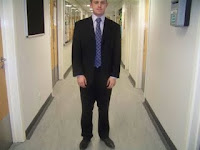
This first image is the main image for the Print Ad, as we are going to use this body and place the pumkin on the top for the head and also change the hands and feet into sweets to connote trick or treating.
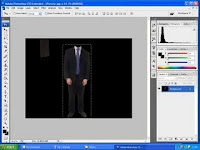
This image is of the body with the head cut out.
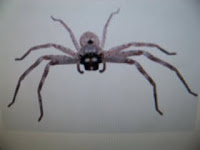
This photo is of a spider simply because in the corner of the Print Ad, we are hoping to have a spiders web with a spider hanging down.
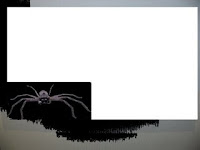
This is of the spider being sorted out on photoshop.
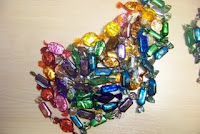
We gathered some sweets to make as feet for out main image. We decided this would connote trick or treating, this would be a benefit for our print ad.
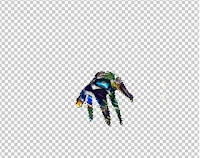
This is the same image as the feet. However we spent a while trying to make hands out of the sweet photo. This image shows how successful it was.
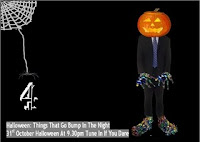
This last image is of the Print Ad finished.
As the pumpkin and sweets have connotations of halloween we just generally thought it would be a good idea.
The images below are simply some images of the making of the Print Ad.

This first image is the main image for the Print Ad, as we are going to use this body and place the pumkin on the top for the head and also change the hands and feet into sweets to connote trick or treating.

This image is of the body with the head cut out.

This photo is of a spider simply because in the corner of the Print Ad, we are hoping to have a spiders web with a spider hanging down.

This is of the spider being sorted out on photoshop.

We gathered some sweets to make as feet for out main image. We decided this would connote trick or treating, this would be a benefit for our print ad.

This is the same image as the feet. However we spent a while trying to make hands out of the sweet photo. This image shows how successful it was.

This last image is of the Print Ad finished.
Subscribe to:
Comments (Atom)
